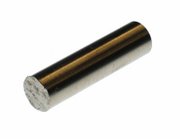Zirconium
2008/9 Schools Wikipedia Selection. Related subjects: Chemical elements
|
||||||||||||||||||||||||||||||||||||||||||||||||||||||||||||||||
| General | ||||||||||||||||||||||||||||||||||||||||||||||||||||||||||||||||
|---|---|---|---|---|---|---|---|---|---|---|---|---|---|---|---|---|---|---|---|---|---|---|---|---|---|---|---|---|---|---|---|---|---|---|---|---|---|---|---|---|---|---|---|---|---|---|---|---|---|---|---|---|---|---|---|---|---|---|---|---|---|---|---|---|
| Name, Symbol, Number | zirconium, Zr, 40 | |||||||||||||||||||||||||||||||||||||||||||||||||||||||||||||||
| Chemical series | transition metals | |||||||||||||||||||||||||||||||||||||||||||||||||||||||||||||||
| Group, Period, Block | 4, 5, d | |||||||||||||||||||||||||||||||||||||||||||||||||||||||||||||||
| Appearance | silvery white |
|||||||||||||||||||||||||||||||||||||||||||||||||||||||||||||||
| Standard atomic weight | 91.224 (2) g·mol−1 | |||||||||||||||||||||||||||||||||||||||||||||||||||||||||||||||
| Electron configuration | [Kr] 4d2 5s2 | |||||||||||||||||||||||||||||||||||||||||||||||||||||||||||||||
| Electrons per shell | 2, 8, 18, 10, 2 | |||||||||||||||||||||||||||||||||||||||||||||||||||||||||||||||
| Physical properties | ||||||||||||||||||||||||||||||||||||||||||||||||||||||||||||||||
| Phase | solid | |||||||||||||||||||||||||||||||||||||||||||||||||||||||||||||||
| Density (near r.t.) | 6.52 g·cm−3 | |||||||||||||||||||||||||||||||||||||||||||||||||||||||||||||||
| Liquid density at m.p. | 5.8 g·cm−3 | |||||||||||||||||||||||||||||||||||||||||||||||||||||||||||||||
| Melting point | 2128 K (1855 ° C, 3371 ° F) |
|||||||||||||||||||||||||||||||||||||||||||||||||||||||||||||||
| Boiling point | 4682 K (4409 ° C, 7968 ° F) |
|||||||||||||||||||||||||||||||||||||||||||||||||||||||||||||||
| Heat of fusion | 14 kJ·mol−1 | |||||||||||||||||||||||||||||||||||||||||||||||||||||||||||||||
| Heat of vaporization | 573 kJ·mol−1 | |||||||||||||||||||||||||||||||||||||||||||||||||||||||||||||||
| Specific heat capacity | (25 °C) 25.36 J·mol−1·K−1 | |||||||||||||||||||||||||||||||||||||||||||||||||||||||||||||||
|
||||||||||||||||||||||||||||||||||||||||||||||||||||||||||||||||
| Atomic properties | ||||||||||||||||||||||||||||||||||||||||||||||||||||||||||||||||
| Crystal structure | hexagonal close-packed | |||||||||||||||||||||||||||||||||||||||||||||||||||||||||||||||
| Oxidation states | 4, 3, 2, 1, ( amphoteric oxide) |
|||||||||||||||||||||||||||||||||||||||||||||||||||||||||||||||
| Electronegativity | 1.33 (Pauling scale) | |||||||||||||||||||||||||||||||||||||||||||||||||||||||||||||||
| Ionization energies ( more) |
1st: 640.1 kJ·mol−1 | |||||||||||||||||||||||||||||||||||||||||||||||||||||||||||||||
| 2nd: 1270 kJ·mol−1 | ||||||||||||||||||||||||||||||||||||||||||||||||||||||||||||||||
| 3rd: 2218 kJ·mol−1 | ||||||||||||||||||||||||||||||||||||||||||||||||||||||||||||||||
| Atomic radius | 155 pm | |||||||||||||||||||||||||||||||||||||||||||||||||||||||||||||||
| Atomic radius (calc.) | 206 pm | |||||||||||||||||||||||||||||||||||||||||||||||||||||||||||||||
| Covalent radius | 148 pm | |||||||||||||||||||||||||||||||||||||||||||||||||||||||||||||||
| Miscellaneous | ||||||||||||||||||||||||||||||||||||||||||||||||||||||||||||||||
| Magnetic ordering | no data | |||||||||||||||||||||||||||||||||||||||||||||||||||||||||||||||
| Electrical resistivity | (20 °C) 421 n Ω·m | |||||||||||||||||||||||||||||||||||||||||||||||||||||||||||||||
| Thermal conductivity | (300 K) 22.6 W·m−1·K−1 | |||||||||||||||||||||||||||||||||||||||||||||||||||||||||||||||
| Thermal expansion | (25 °C) 5.7 µm·m−1·K−1 | |||||||||||||||||||||||||||||||||||||||||||||||||||||||||||||||
| Speed of sound (thin rod) | (20 °C) 3800 m/s | |||||||||||||||||||||||||||||||||||||||||||||||||||||||||||||||
| Young's modulus | 68 GPa | |||||||||||||||||||||||||||||||||||||||||||||||||||||||||||||||
| Shear modulus | 33 GPa | |||||||||||||||||||||||||||||||||||||||||||||||||||||||||||||||
| Poisson ratio | 0.34 | |||||||||||||||||||||||||||||||||||||||||||||||||||||||||||||||
| Mohs hardness | 5.0 | |||||||||||||||||||||||||||||||||||||||||||||||||||||||||||||||
| Vickers hardness | 903 MPa | |||||||||||||||||||||||||||||||||||||||||||||||||||||||||||||||
| Brinell hardness | 650 MPa | |||||||||||||||||||||||||||||||||||||||||||||||||||||||||||||||
| CAS registry number | 7440-67-7 | |||||||||||||||||||||||||||||||||||||||||||||||||||||||||||||||
| Selected isotopes | ||||||||||||||||||||||||||||||||||||||||||||||||||||||||||||||||
|
||||||||||||||||||||||||||||||||||||||||||||||||||||||||||||||||
| References | ||||||||||||||||||||||||||||||||||||||||||||||||||||||||||||||||
Zirconium (pronounced /zɚˈkoʊniəm/, /ˌzɝˈkoʊniəm/) is a chemical element with the symbol Zr and atomic number 40. It is a lustrous, gray-white, strong transition metal that resembles titanium. Zirconium is never found as a native metal, but is instead obtained mainly from the mineral zircon. Zirconium is used as an alloying agent due to its high resistance to corrosion.
Characteristics
Zirconium is a lustrous, grayish-white, soft, ductile, and malleable metal which is solid at room temperature, though it becomes hard and brittle at higher purities. In powder form, zirconium is highly flammable, but the solid form is far less prone to igniting. Zirconium is highly resistant to corrosion by alkalis, acids, salt water, and other agents. However, it will dissolve in hydrochloric and sulfuric acid, especially when fluorine is present. Alloys with zinc become magnetic below 35 K.
The melting point of zirconium is at 1855°C, and the boiling point is at 4409°C. Zirconium has an electronegativity of 1.33 on the Pauling scale. Of the elements within d-block, Zirconium has the fourth lowest electronegativity after yttrium, lutetium, and hafnium.
Applications
Because of Zirconium's excellent resistance to corrosion, it is often used as an alloying agent in materials that are exposed to corrosive agents, such as surgical appliances, explosive primers, vacuum tube getters and filaments. Zirconium dioxide (ZrO2) is used in laboratory crucibles, metallurgical furnaces, and as a refractory material. Zircon (ZrSiO4) is cut into gemstones for use in jewelry. Zirconium carbonate (3ZrO2·CO2·H2O) was used in lotions to treat poison ivy, but this was discontinued as it caused bad skin reactions in some cases. 90% of all zirconium produced is used in nuclear reactors because of its low neutron-capture cross-section and resistance to corrosion. Zirconium alloys are used in space vehicle parts for their resistance to heat, an important quality given the extreme heat associated with atmospheric reentry.
History
The zirconium-containing mineral zircon, or its variations ( jargoon, hyacinth, jacinth, ligure), were mentioned in biblical writings. The mineral was not known to contain a new element until Klaproth analyzed a jargoon from the island of Ceylon in the Indian Ocean. He named the new element Zirkonerde (zirconia). Humphry Davy attempted to isolate this new element in 1808 through electrolysis, but failed. Zirconium (from Syriac zargono, Arabic zarkûn from Persian zargûn زرگون meaning "gold like") was first isolated in an impure form in 1824 by Berzelius by heating a mixture of potassium and potassium-zirconium fluoride in a small decomposition process conducted in an iron tube.
The crystal bar process (or Iodide process), discovered by Anton Eduard van Arkel and Jan Hendrik de Boer in 1925, was the first industrial process for the commercial production of pure metallic zirconium. It was superseded by the Kroll process, developed in the 1940s.
Occurrence
Geological
Zirconium has a concentration of about 130 mg/kg within the earth's crust and about .026 μg/L in sea water, though it is never found in nature as a native metal. The principal commercial source of zirconium is the zirconium silicate mineral, zircon (ZrSiO4), which is found in deposits located in Australia, Brazil, India, Russia, South Africa, and the United States. 80% of zircon mining occurs in Australia and South Africa. Zirconium and hafnium are both contained in zircon and they are quite difficult to separate chemically due to their similar chemical properties. Zircon resources exceed 60 million metric tons worldwide and annual worldwide zirconium production is approximately 900,000 metric tons.
Zircon is a by-product of the mining and processing of the titanium minerals ilmenite and rutile, as well as tin mining. From 2003 to 2007, zircon prices have steadily increased from $360 to $840 per metric ton. Zirconium also occurs in more than 140 other recognized mineral species including baddeleyite and kosnarite. This metal is commercially produced mostly by the reduction of the zirconium(IV) chloride with magnesium metal in the Kroll process. Commercial-quality zirconium for most uses still has a content of 1% to 3% hafnium.
This element is relatively-abundant in S-type stars, and it has been detected in the sun and in meteorites. Lunar rock samples brought back from several Apollo program missions to the moon have a quite high zirconium oxide content relative to terrestrial rocks.
Biological
Zirconium has no known biological role, though zirconium salts are of low toxicity. The human body contains, on average, only 1 milligram of zirconium, and daily intake is approximately 50 μg per day. Zirconium content in human blood is as low as 10 parts per billion. Aquatic plants readily take up soluble zirconium, but it is rare in land plants. 70% of plants have no zirconium content at all, and those that do have as little as 5 parts per billion.
Compounds
As a transition metal, zirconium forms various inorganic compounds, such as zirconium dioxide (ZrO2). This compound, also referred to as zirconia, has exceptional fracture toughness and chemical resistance, especially in its cubic form. These properties make zirconia useful as a thermal barrier coating, though it is also a common diamond substitute. Zirconium tungstate is an unusual substance in that it shrinks in all directions when heated, whereas other elements expand when heated. Other inorganic zirconium compounds include zirconium (II) hydride, zirconium nitride, and zirconium tetrachloride (ZrCl4), which is used in the Friedel-Crafts reaction.
Organozirconium chemistry is the study of compounds containing a carbon-zirconium bond. These organozirconium compounds are often employed as polymerization catalysts. The first such compound was zirconocene dibromide, prepared in 1952 by John M. Birmingham at Harvard University. Schwartz's reagent, prepared in 1970 by P. C. Wailes and H. Weigold, is a metallocene used in organic synthesis for transformations of alkenes and alkynes.
Isotopes
Naturally-occurring zirconium is composed of five isotopes. 90Zr, 91Zr, and 92Zr are stable. 94Zr has a half-life of 1.10 × 1017 years. 96Zr has half-life of 2.4 × 1019 years, making it the longest-lived radioisotope of zirconium. Of these natural isotopes, 90Zr is the most common, making up 51.45% of all zirconium. 96Zr is the least common, comprising only 2.80% of zirconium.
28 artificial isotopes of zirconium have been synthesized, ranging in atomic mass from 78 to 110. 93Zr is the longest-lived artificial isotope, with a half-life of 1.53 × 106 years. 110Zr, the heaviest isotope of Zirconium, is also the shortest-lived, with an estimated half-life of only 30 milliseconds. Radioactive isotopes at or above mass number 93 decay by β-, whereas those at or below 89 decay by β+. The only exception is 88Zr, which decays by ε.
Zirconium also has six metastable isomers, 83mZr, 85mZr, 89mZr, 90m1Zr, 90m2Zr, and 91mZr. Of these, 90m2Zr has the shortest half-life at 131 nanoseconds. 89mZr is the longest lived with a half-life of 4.161 minutes.
Toxicity
Inhalation of zirconium compounds can cause skin and lung granulomas. Zirconium aerosols can cause pulmonary granulomas. Persistent exposure to zirconium tetrachloride resulted in increased mortality in rats and guinea pigs and a decrease of blood hemoglobin and red blood cells in dogs. OSHA recommends a 5 mg/m3 time weighted average limit and a 10 mg/m3 short-term exposure limit. Ingestion or inhalation of 93Zr, a radioactive isotope, causes a slight increase in the likelihood of developing cancer.



